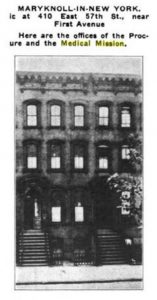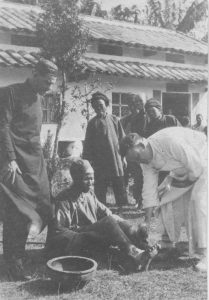During this time of crisis we are experiencing a renewed and deepened sense of appreciation and admiration for all medical personnel.
Maryknoll Fathers and Brothers connection to the medical community, especially in New York City, dates back to their earliest days.
Training by U.S. medical personnel is the reason early Maryknollers could provide health care to the people they served in China.
Today’s post is dedicated to the service they provided.
Dr. Flagg, a renowned physician on the staff of St. Vincent’s Hospital in New York City, was an enthusiastic supporter of Catholic medical mission work, founder of the Catholic Medical Mission Board (1912) and one of the Society’s earliest collaborators. According to the Society’s publication, The Field Afar, Dr. Flagg attended the Catholic Hospital Association’s June 1922 conference in Washington, D.C. as a representative from Maryknoll. “Dr. Flagg…pointed out the similarity of diseases at home and in the missions, [and] advocated propaganda among young medical students and internes, who should be encouraged to take up medical mission work, as a short post-graduate service. He placed medical mission activities upon the broad shoulders of the Catholic hospital as a duty and as an integral part of its divine activity.”
Dr. Flagg would also come to have a very personal investment in Maryknoll. His oldest child, Virginia, entered the Maryknoll Sisters congregation in 1930. Her first mission assignment was to Dairen, Manchuria in 1935.
By 1921, the aims of the Maryknoll Medical Department included providing medical instruction for Seminary in New York and the Venard College in Clark’s Summit, Pennsylvania; medical attendance with the formation of a staff of medical consultants; and medical supplies including drugs, textbooks and apparatus for the missions.
The Medical Bureau’s focus on training missioners and supporting the Society’s medical mission work is clear in Dr. Flagg’s report on the 1921-1922 school year as recorded in the February 1922 issue of The Field Afar.
“Instruction
Since the opening of the school year in September an effort has been made to formally organize our instructors under the American Red Cross. […] We have now at the disposal of the Society for purposes of teaching, three physicians and three nurses. […] Dr. H. E. Huntington, of Ossining, who recently joined our staff, has just delivered ten lectures in Anatomy, Physiology and First-Aid, combined. Ten lectures on Essentials of Medicine were delivered by Dr. P. J. Flagg to students who have had First-Aid.
During the coming session Dr. Huntington will conclude his course in Anatomy and First-Aid with twenty additional lectures. A course of twenty lectures in Tropical Medicine will also be delivered to the graduating class. Twelve additional lectures will conclude the course in Essentials of Medicine. Mr. Frederick Gould of Bellevue Hospital has consented to give five demonstrations in Laboratory Technique.
The plan of instruction for this year, therefore, provides thirty lectures in Anatomy, Physiology, and First-Aid, twenty-two lectures in Tropical Medicine, and five lectures in Laboratory Technique.
During the summer months for the past two years, groups of students have spent periods of a month in either St. Francis’ or St. Vincent’s Hospitals, New York City. Through the kindness and interest of the Sisters they have been enabled to witness operating room and dispensary work and to aid in the ward medication.
Supplies
All of the outgoing missioners, including the Superior, received prophylactic, typhoid, and smallpox vaccine. In addition a number of medical books and supplies have been furnished. It is planned to supply more generously, adequately and systematically the missioners who next depart. Eight hundred and fifty dollars ($850) have been pledged for Medical Mission Work to date. About one-third has been received.”
Tungchen, Sunyi
Kwangtung, China
1922
Dear Doctor,
I think a great deal more of you now that I have a couple of years in China. By which I do not mean to say that I failed to think a lot of you before and appreciate your great interest in medical missions. In fact, I did. But I did not realize until I had some personal experience over here, the importance of the medical feature in modern missions.
As you probably know by this time, I am in charge of Fr. Meyer’s former mission, Tungchen. Fr. Meyer started the ball rolling last year and now the dispensary exists on a rather big scale, taking up from one to three or more hours a day of our time. Sometimes there is a regular mob in attendance. The commonest ailments are legs with open sores, worms, malaria, swollen limbs, aches in the bones and several kinds of skin diseases. We can do a lot of good in most cases…
[…] I wish I had the chance to sit at your feet again and learn. There would be many questions to ask you… Sad to say, that time and opportunity have gone; so I have to get along as well as I can.
I am eagerly looking forward to the day when we shall have an American doctor in our midst. He would be a great help to us and could take care of the surgical work, which we may not and cannot attempt. I hope the day will soon come.
With best regards to the Maryknollers, I remain, Dear Doctor,
Yours sincerely in Christ,
Frederick C. Dietz
In 1930, medical mission would come to full embodiment as Dr. Harry P. Blaber became the Society’s first lay missioner. Dr. Blaber was a graduate of the Long Island College of Medicine and a physician in Brooklyn, New York. His mission work began in Kongmoon, China where he opened the Tung On dispensary in a small house that he partitioned into consultation room, clinic, surgery, pharmacy, laboratory and six-bed ward. His patients, who soon began to call him “the doctor of a thousand cures,” lined up in the street at the rate of over 50 per day.





